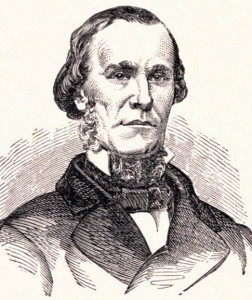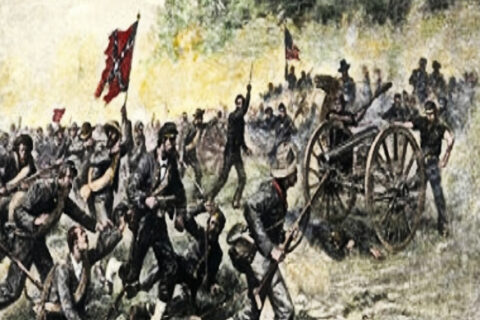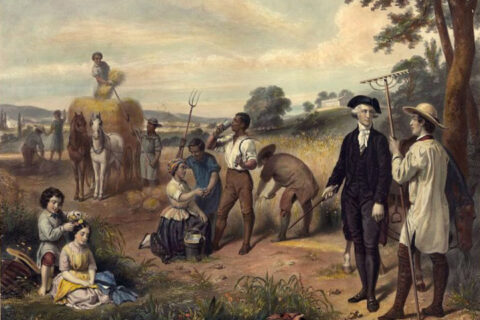“Take a good look my dear. It’s an historic moment you can tell your grandchildren about – how you watched the Old South fall one night.”
Rhett Butler speaking to Scarlett O’Hara about the Fall of Atlanta
Georgia’s long history often separates it from the rest of its Deep Southern contemporaries. Initially founded as a penal colony, the state rapidly shifted to a chattel-based economy as South Carolinians moved into the state. With consistent influx of population throughout its early history, including the aforementioned South Carolinians, Appalachians from Augusta and the northwest corner of the state, and the culturally non-Southern Atlanta introducing endless immigration and movement, the state developed a unique demographic makeup which effects it contemporarily and did as well during the antebellum period, the latter period brandishing the state with a controversially anti-secession position. The brutish rapine of Union invasion during the final year of the war worked against the Radicals’ desire during the following Reconstruction and turned the heavily pro-Union, eclectic population against them, setting the stage for a sui generis Reconstruction experience and subsequent socio-political history. This essay will analyze the Reconstruction period as it occurred in Georgia economically, politically, and socially.
Simply stated, Georgia existed in total, abject poverty following the War. Largely due to the destruction of the plantation economy and chiefly a result of Sherman’s March to the Sea, the poverty in the state became part of the Southern mythology. However, the economy of the state differed greatly from its Deep South contemporaries, excepting possibly Alabama. Georgia’s urban areas were far more developed than the rest of the Deep South. Atlanta held a notorious reputation for being characteristically non-Southern, being one of the country’s early metropolitan areas and introducing vast numbers of immigrants into the area. Additionally, Georgia’s cities operated as a major railroad hub within the former Confederacy and supplied many of the largest railroad corporations in all of Dixie. Savannah, Augusta, and Columbus all experienced speedy recoveries fueled largely by the influx of demand from locals having gone for so long without the luxuries of life they had grown accustomed to. However, the shocking resurgence of Atlanta, compounded by the rebuilding of the three aforementioned urban areas, brought the state ahead of the other Deep South states. Despite Sherman’s Army utterly razing 75% of the city, Atlanta had made a full recovery and had exceeded previous population numbers by 1866.
However, the term “recovery” may only be applied in a shallow sense. Though it initially experienced a spike in business and rebuilding during the first year and a half after the War, the optimistic nature of the economic situation soon petered out. The cause of the seemingly quick recovery was largely due to the exorbitant levels of demand with little long term supply to sustain it. Despite its failure, the economy remained an integral facet of Reconstruction in Georgia due primarily to its eclectic population and large urban centers, leaving it as the only state in the Deep South to embrace the Democratic New Departure movement.
Politics of the state pre-1867 avoided the tumultuous nature in comparison to the rest of the Deep South. Johnson’s presidential plan placed Union Democrat James Johnson in the position of provisional governor in June of 1865, favoring his moderate positions over that of the more divisive Whig Joshua Hill. Primarily presiding over the constitution convention and restoring order, Johnson’s tenure was short lived.
The sub-par electorate to the convention compiled a new state constitution which successfully sought ratification shortly afterward. By 1866, the state had elected a legislature arguably comprised of the best representatives available and had elected as governor Charles Jenkins, who served until his removal in 1868. Jenkins finally restored legitimate order to the state, serving as a moderate figure within the Democratic Party. The state existed in relative quietude until the election of Alexander Stephens and Herschel Johnson to the U.S. Senate. Their, and other Southern States’ Senatorial choices’, allegiance to the Confederacy, despite the former’s Whig loyalties and the latter’s anti-secessionist sympathies, raised a firestorm in the Radical government, resulting in inordinate legislative backlash.
The Reconstruction Acts of 1867 began the second phase of Reconstruction in Georgia as it did in the rest of the former Confederacy. Georgia was place into the Third Military District under the initial command of General George Meade. Placed under the military governorship of General Thomas Ruger from January to July 1868, the state quickly wrote and ratified a new state constitution and elected Rufus Bullock as the official Governor. However, the Conservatives commanded considerable power within the General Assembly and managed to exert their influence by removing the Negro legislators from both house, albeit only temporarily; congruently, the state voted Democrat alongside Louisiana in the presidential election of 1868, all to the chagrin of Congress.
Lastly, the 15th Amendment was refused ratification by the General Assembly. Interestingly enough, the Conservative dominated House resoundingly voted to ratify the 15th Amendment, seeking an end to Radical control. However, the Republican dominated Senate rejected the amendment, despite being more under the direct influence of Governor Bullock. Adding another facet of mystique to the situation, the most fervent supporters of the Bullock regime in the State Senate refused to attend during the final vote. Of the Senate’s 44 members, only 29 voted.
The aforementioned actions of the Conservative faction provided for Governor Rufus Bullock the evidence he needed to make an appeal to Congress in 1869 for reinstatement of military rule. Bullock, being elected governor in 1868 and serving until 1871, served in the Confederate military as a quartermaster officer during the War despite originally being from New York, yet deeply embedded himself in corrupt relationships during Reconstruction. While the state lacked the superfluous taxes and spending seen in its sister states, the financial corruption attributable to the Radicals manifested as the gratuitous granting of bonds and mismanagement of the various large railroad companies in the state, as well as, Bullock’s incessant handouts to his friends and proteges. Congress also placed Georgia back under military rule in 1869 in response to Bullock’s appeal. By Reconstruction’s end, Georgia had been under military occupation on three separate occasions. Needless to say, his reputation had been wholly tarnished upon his resignation in 1871 and was, at one point, labeled “the most hated man in Georgia.”

Other than Bullock, the most pivotal actors during Radical Reconstruction were business magnate Hannibal Kimball, railroad executive Foster Blodgett, and former Confederate Governor Joseph Brown. Hannibal Kimball owned the Atlanta Opera House, which housed where the General Assembly met at the time, and Foster Blodgett was the head of the Western and Atlantic Railroad. Both individuals conspired alongside Bullock to embezzle money, often utilizing the railroad to do so.
Ex-Governor Brown, surprisingly, maintained a considerable level of political power despite not being in office. Brown consistently stood in the background of each pivotal moment throughout the period. Despite being the first in line to support secession, he quickly swung in favor of President Johnson’s Reconstruction policy. He championed the 14th Amendment once it became apparent Johnson’s plan was destined to be subdued. Brown would later switch to the Republican Party and embed himself in Blodgett’s and Bullock’s affairs. He also was one of the first men to greet General John Pope upon the latter’s arrival in Georgia as commander of the Third Military District. Lastly, Brown quickly became one of the first supporters of Democrats’ reorganization upon realizing the Republicans’ impending downfall, in 1872 being one of the escorts of the first Democratic governor since the end of the War to the recently won chair. Brown would cement himself in infamy in Georgia’s political history and would later become a defining member of the Bourbon Triumvirate.
The social conditions of Georgia between the end of the War and 1867 often lacked the minacious characteristic typically reported in Northern newspapers. The transition to free Negroes took place with marginally less effort than neighboring states. Numerous plantation owners quickly took to reemploying their freed Negro labor and began the process of wages. While frustrated at the difficult nature of Negroes under the new circumstances, relations remained on good terms. However, Appalachians and an assortment of poorer whites clashed with Negroes and disliked their presence; alongside them, carpetbaggers and occupational forces developed irascible behavior towards locals, particularly freed slaves. Though Southerners generally accepted their new rulers, many, particularly women, made social life for carpetbaggers as difficult as possible, but their financial pursuits were uninhibited. Unfortunately, this attitude of quietude and situation of self-government was short lived. Negroes received all legal rights and privileges that Caucasians had with the exception of suffrage and the opportunity to sit on juries. Simply stated, even the most moderate of plantation owners could not fathom the idea of an uneducated, freed slave having totally equal footing to white men; on the other had, Appalachians, poor whites, occupational military forces, and carpetbaggers held a feeling of outright disgust for blacks.
The passage of the Reconstruction Acts of 1867 overturned Georgia’s peaceful repose. Placed, again, under military occupation and again a third time under Governor Bullock, Georgians grew increasingly exasperated. Not in coincidence, this generated more desire among the population to resist Radical Reconstruction.
Violent acts grew in intensity following 1867, with the locals setting aside placid resistance to outright intemperate belligerence. By 1868, Ku Klux organizations established throughout the state, generally wherever large groups of Appalachians lived. Though irrelevent prior to 1868, the moniker abruptly entered the Georgia scene on March 31, 1868, shocking many with the homicide of Republican organizer George Ashburn in Columbus. Ku Klux activity grew to such a degree that the state was one of only two former Confederate states to vote in favor of Heratio Seymour in 1868. Murders and intimidation continued well into 1870. Most of the unrest was concentrated in the Black Belt and extended from there into the northwestern region of Georgia. Activity declined as the federal government began employing particularized anti-Ku Klux measures, the most effective of which were by U.S. Attorney General Amos Akerman. The final nail in the coffin of Klan violence in Georgia was the Redemption of the state and ousting of Bullock in 1871.
Georgia’s Reconstruction underwent a bizarre and interconnected series of political and financial scenarios which can more easily be described as corrupt and fraudulent, instead of blatant oppressive malice. Analyzing the economic, political, and social circumstances of the era presents a largely non-violent political affair which ended quite early, considering the state’s Deep South positioning. Though integral to the later development of clashing between liberal and conservative factions of the Democratic Party due to its large urban centers, Georgia sat solidly in one-party control after 1872 as it began the process of voter regulation and later vicious racial policies due to Whiggish influence. Despite the decline and usurpation of the Old South in Georgia, the state still chased away its conquerors and instilled its own society which would last until the 1960’s, one not wholly “Gone with the Wind.”
“The White people of the South are the greatest minority in this nation. They deserve consideration and understanding instead of the persecution of twisted propaganda.” –Strom Thurmond






Thank you: Musonius Rufus on Reconstruction and the 14th Amendment https://www.podomatic.com/podcasts/tkelly6785757/episodes/2020-09-09T04_27_12-07_00
my OCD Warning’s against global “messianic” puritanical/calvinist monarchy: the Hamiltonian’s are starting to showing their true colors now: The Return Of The King https://thezman.com/wordpress/?p=21218
Do see also Jefferson’s warning also on Hamilton’s monarchy: https://www.abbevilleinstitute.org/blog/poison-under-the-wings/
what’s up with the sudden influx of these weird Hebrew roots Christian identitarian cult ding dongs telling us Israel is bad like we don’t already know it